Michael Landau: “People go insane comparing different amps… The cabinet and speakers make far more difference”
The session maestro on his Custom Shop Strat, touring with James Taylor, and channelling Hendrix and Cream
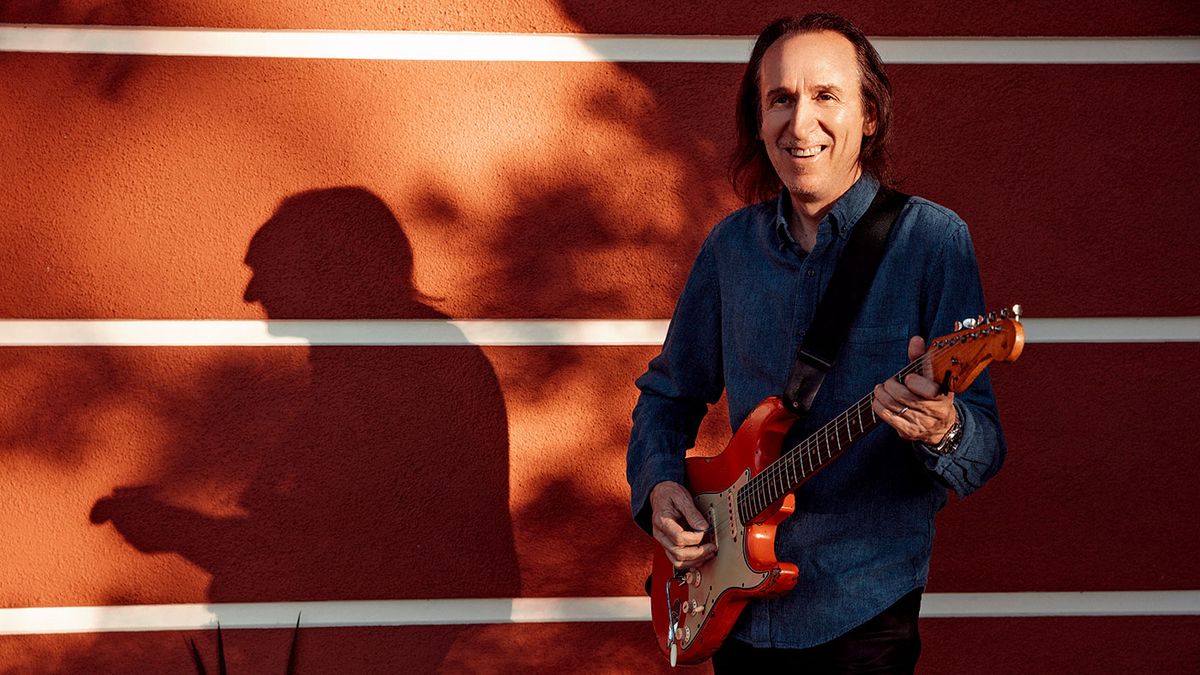
On the one hand he’s the consummate, guitar player’s guitar player and solo artist - everybody who’s anybody loves Landau.
On the other he’s the unassuming sideman and session cat who’s played on records from artists as diverse as Joni Mitchell and Christina Aguilera, to Pavarotti, Michael Bublé, Sugarland, Tim McGraw and many, many more. His AllMusic.com discography credits make for a simply jaw-dropping read.
For 2018 Michael Landau turns his attentions inwards and draws on the key influences and inspirations that first lit his fire as a musician. However, his new album, Rock Bottom, is no exercise in nostalgia.
Moreover it’s a characteristically edgy, eclectic and contemporary collection of new songs recorded at his home studio in California, with old mucker Dave Frazee on vocals alongside a stellar bunch of bandmates. It’s the perfect excuse for a long-overdue catch-up…
It basically goes back to the music that I grew up on. Cream and Hendrix and The Beatles
The new record sounds remarkable - even as an mp3 the depth and dynamic range is really noticeable. How did you record it?
“Oh thanks, I’ve been getting some good feedback! I have a small studio at my house - a converted garage and a control room that’s basically the bedroom right next to it. It’s funky, it’s small, but I have nice equipment - a good API board and a lot of Neve mic preamps. We actually did the basic tracks to tape - I have a Studer A827 [classic two-inch reel-to-reel multitrack tape machine], so we did the basic tracks on it and finished it up in the ol’ ProTools.”
How hard is it to self-produce - to wear the hats of both musician and producer?
Get the MusicRadar Newsletter
Want all the hottest music and gear news, reviews, deals, features and more, direct to your inbox? Sign up here.
“Well I like doing it - it’s time-consuming and I definitely worked hard on this one, getting the vocals the way we wanted them and I took my time with guitar sounds. It’s not easy but I know what I wanted to hear.”
There’s an edge that comes over on the first couple of listens - a little bit of aggression, energetic malcontent, perhaps. What was your inspiration there?
“It basically goes back to the music that I grew up on. Cream and Hendrix and The Beatles… that’s all just in there and I had been playing so much instrumental music for the last 10 years with my trio and also with the Steve Gadd Band… all instrumental, so it was time to rock a bit!”
Who else plays on the record?
“My brother Teddy Landau plays most of the bass on most of the tunes - seven of them I think - and Jimmy Johnson plays bass on a couple of tracks. It’s mostly a drummer named Alan Hertz, plus a drummer from Nashville named Shannon Forrest overdubbed on a couple of tunes. Gary Novak played drums on one song and Larry Goldings played organ on most of the album. Larry is one of my favourite musicians of all time. That straight-up Hammond, woody sound goes so nicely with guitars, y’know.”
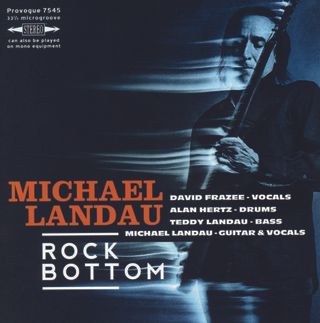
Preparing to improvise
Improvisation and spontaneity form a big part of your style as a live musician, so when you’re making a record, how do you create the environment for that - is it even possible?
“It’s completely different for sure. That’s what I love about live in that it’s just right there: a sink-or-swim situation in a small room with a bunch of other people and it’s a moment in time. I love that.
“It’s easier, live, to get in a zone and for better or worse, come up with improvising on the spot. It is harder in the studio, but I generally try to record at night with the lights a little bit lower when I’m doing guitars and stuff. It’s difficult, y’know; you’re sitting in a control room and there’s just the engineer in there with you. It’s kinda hard to get in that zone, but I just keep hacking at it until I like it.”
There’s a lot of freedom and space for your guitars throughout the record, and yet there’s plenty of depth and layers too with quirky sounds and textures making appearances here and there… Is that a process of listening back and refining, or is it all in your head to begin with?
My '63 Strat’s probably the favourite of all my guitars. The signature came out great, I thought. They came really close to nailing it
“It’s a lot of listening back. Originally I just wanted to do a trio record - with a vocalist too - and keep it pretty minimal, but I’ll just try things and if a song looks like it’s gonna go towards more overdubs, I’ll just go with it until it sounds like it’s too much and then back off a little bit. So yeah, I wanted it to be a little more raw, live in the studio, but then I like the textures too, so I kept putting them on.”
Your ’63 Strat features highly on the record… was that the one Fender you looked at for one of your signature guitars?
“Yeah, that’s probably the favourite of all my guitars. Those came out great, I thought. They came really close to nailing it, in terms of sound and looks and feel. I was really happy with it. I’ve played a bunch of them and they were all just super-nice guitars.”
What about the fingerboard radius? Some people were surprised you went for the true vintage radius.
“I really do prefer the vintage, seven-and-a-quarter [inch radius] over the nine-and-a- half. It just feels great to me. I have my action - I mean I wouldn’t say it’s insanely high - I would call it normal. It’s not low, and there’s a tiny bit of choking on some of the notes, but I don’t know… It’s got a feel to it that feels much better to me. And frets too - they’re Fender ones, like a Dunlop 6105 but maybe not quite as tall.
“In fact, I also used a Jazzmaster a lot for the clean-crunchy stuff on the record, and also for some of the more effected stuff with the modulation. This particular one I have has a killer neck pickup. It almost sounds like a jazzbox - very old-time sounding. It’s a 1975 guitar I think - I got lucky with that one.
“And one thing I love about that Jazzmaster is that the frets are really low, and I’ve noticed the intonation is just so great, the chords are so in tune. I hadn’t realised that these high frets I’ve been using all these years will definitely make it go sharp and out of tune. The downside is that you can’t bend as well with the lower frets, so it’s all a compromise - you gotta work at it.”
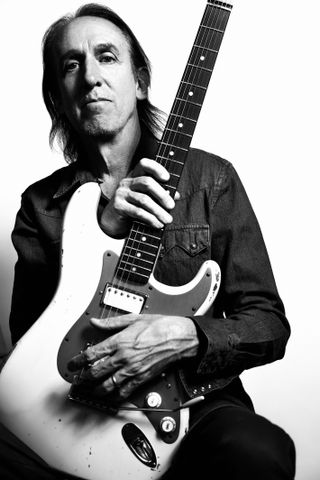
Late-'60s Strats
You have a couple of late-'60s Strats as well - what is it about those for you?
“I’m just a fan of that big headstock. As I say, the ’63 is probably my favourite, but there’s something about that big headstock - a little more mass down there or something… and it’s kinda wicked looking. The two late-60s ones I have - the black one is a ’69 and the ’68 is Sunburst - don’t have the original grey-bottom pickups and that’s supposedly a major difference between the earlier and later '60s ones. That would be something that would separate them, but I just look at a guitar in general - that it’s playing right, the feel, the lightness of the body.
I remember my mom taking me to see Woodstock when I was 11 years old. Maybe that big headstock got ingrained in there
“Maybe it’s a Jimi thing. I remember my mom taking me to see Woodstock when I was 11 years old. Maybe that big headstock got ingrained in there!”
What about pickups? You’ve been backwards and forwards with traditional single coils and humbuckers, your Suhr pickups… is it fair to say that you’ve come back to a more vintage preference for sound?
“Mostly yes, except for this new Custom Shop Strat that I’ve been playing for about a year that has two humbuckers [F-spaced Lollar Imperials]. I did that because trying to combine single coils and humbuckers, you’re always left with that compromise of the 250k pot vs the 500k pot. Humbuckers always sound much better to me with the 500k pots.
“There are a lot of companies that are making great new pickups, but I’m still not sure. They’re so close to sounding like the originals and I just don’t quite understand that extra five or 10 per cent magic. I’ve gone nuts with this, swapping pickups over the years and I’ve got to thinking that maybe it’s something to do with the old metal on the guitars. John Suhr says it can be softer metal, which I wouldn’t have thought, but I guess the only way to find out would be to put new pickups in an old guitar and see what that brings. But I do, I tend to just to just go for straight-ahead, vintagey stuff, definitely.”
Does there come a point where you’ve been down the rabbit hole enough with trying to refine tone?
Tone becomes about chasing your tail at some point and you have to say that it’s good enough
“Oh hell yeah! Chasing the tail definitely. It’s fun to get together with friends and try out a bunch of stuff - I do that with Kirk [Fletcher] a lot, but it becomes about chasing your tail at some point and you have to say that it’s good enough… now it’s time to play some music.”
And what about getting those guitars down to tape? Your recorded sounds are always immense - this record especially - so how do you approach it in the studio?
“Recording guitar has always been pretty basic for me. I use a [Shure SM] 57 most of the time. I like one mic on an amp. I don’t like the combination of two mics because it does a funny cancellation thing and you end up having to put both mics in not the best position. I also like the Royer [R-122V valve ribbon mic], so I just find the right spot and I rarely EQ guitar. Definitely not when I’m printing it. Maybe on the desk there’ll be a 2dB of 5kHz or something like that just to spark it up a bit. I don’t use compression when I’m recording, maybe a little bit during mixing, but if a guitar amp is distorting it’s already compressing nicely.
“I just want to hear it pure and punchy. A nice microphone and pre[amp]… I dunno, I’m always happy with the sound at my place, and the place where I put my control room seems to be perfect for the single-coil hum. Sometimes I’ll go to a studio in Hollywood and it’s insane for hum.”
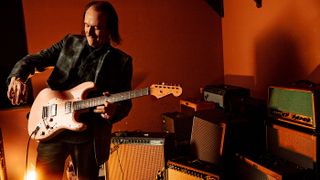
Cabinets are key
What are the main amps on the record? You’ve used pretty much everything over the years…
“The [1964 Fender] Princeton, always, and I record a lot with the Suhr Bella and a Badger 35. The last couple of years I’ve fallen back in love with the vintage [Celestion] Greenback speakers again. I ended up buying a lot of them and I have a couple of nice 4x12 cabinets at the house with the real Greenbacks in them. Even with the Princeton, I’ll plug in two 16-ohm cabinets to make it an eight-ohm load that the Princeton likes. And those Greenbacks are on 90 per cent of the record probably. Even though it’s a small amp I’ll put it through those 4 x 12s to get that nice, closed-back tightness.
The cabinet and speakers, to me, that makes far more difference than the actual amp head
“Let’s see, I have a Dumble Slide Winder too. It’s a 50-watt, four-input Bassman kinda thing, and also this Newcomb Pathfinder 18-watt PA head converted to a guitar amp. But mainly it’s the Suhrs and the Princeton.”
Is there a sweet spot with lower-wattage amps and recording? Almost where big amps can actually sound smaller?
“I think so, absolutely. You can play through a five-watt amp in the studio and the size of the note can be amazing. If you plug into a 100-watt Marshall and you compare that to a 10- or 12-watt amp, the notes are somehow bigger, especially if you put it through the same cab. The mic doesn’t know the level that you’re playing at.
“There’s also a theory that I have… people go insane about comparing different amps, and I can prove this because I’ve done it. If you have four or five amp heads of the same class of tube - two 6L6, or two 6V6 or whatever - if you compare all five of those amps through the same cabinet and you record it, you can get them to sound pretty much identical… as long as they’re nicely made amps of course.
“So the cabinet and speakers, to me, that makes far more difference than the actual amp head. It’s a physical thing at that point. Once you take away the variables - the cabinet, and keep it the same - most amps can start to sound remarkably similar. The feel can be different of course.”
Talking about amps, the Fender ML Deville has been very successful… [Fender released a Michael Landau signature Hot Rod Deville in 2015]
I’m out with JT [James Taylor] again. I love doing that gig because his music is pretty challenging and it’s important to have both things
“Yeah we just took out the overdrive part, which some people complained about, but I didn’t use it and I think a lot of people didn’t. It’s a great go-to amp that started out with being on tour and having to rent amps.
“I did a tour with Kirk [Fletcher] actually, years ago and the Hot Rod Deville was a great amp we rented, loud and relatively small… it just worked, so the signature model really started there. I set my amps so they’re just a little dirty and do the rest with pedals for live - I kinda like simple amps.”
Speaking of live, you’ve been over our neck of the woods...
“Yes, we came over to Europe at the end of February and are continuing throughout March. I’m doing six nights at Ronnie Scott’s [26-31 March] with the Steve Gadd Band in the UK.”
And how’s the rest of your playing life?
“Busy! I’m out for five months straight. Right after The Steve Gadd Band tour, I’m out with JT [James Taylor] again. It’s definitely the yin and yang [from the solo and instrumental material]. I love doing that gig because his music is pretty challenging and it’s important to have both things. It definitely makes the other side so much more interesting when you switch it over. It keeps it fresher to mix it up a little bit.”
Rock Bottom is out now on Provogue/Mascot Label Group.

“The mini humbucker fits into the same sized pickup cavity as a P-90 and delivers low-noise humbucking pickup performance and a slightly brighter and more open tone”: Gibson remixes the Les Paul Special with mini humbuckers
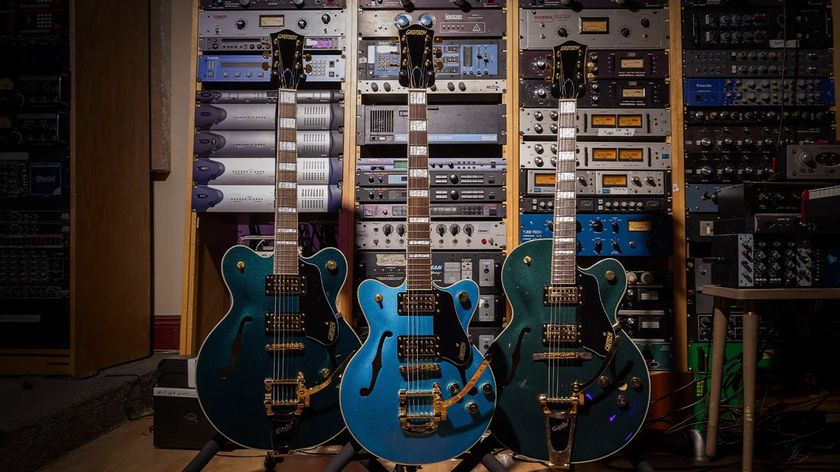
“Exceptional performance, sound, and style at an incredible value.”: Gretsch unveils trio of limited edition Streamliner electrics that offer Bigsby wobble, semi and hollow-bodied rock ’n’ roll mojo for $699





![Chris Hayes [left] wears a purple checked shirt and plays his 1957 Stratocaster in the studio; Michael J. Fox tears it up onstage as Marty McFly in the 1985 blockbuster Back To The Future.](https://cdn.mos.cms.futurecdn.net/nWZUSbFAwA6EqQdruLmXXh-840-80.jpg)






